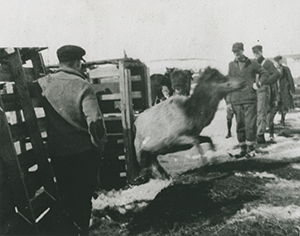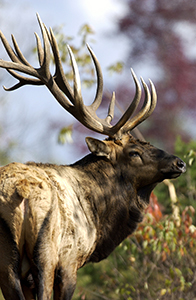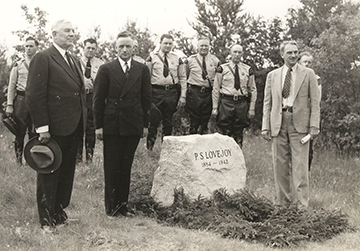Pigeon River Country’s uniqueness
The 100-year history of the Pigeon River Country is told in the forest’s Discovery Center, opened a year ago by a group of dedicated volunteers. The interpretive center is housed in a historic home that was used as a residence for the forest supervisor until the early 2000s.

“We knew we wanted to tell the history, because the history is so important,” said volunteer Sandra Franz, who was on the committee that brought the Discovery Center to life. “We also wanted to inform people who come out that it’s not a state park. It’s a state forest, and here’s what makes the Pigeon River Country unique as a state forest.” One of those things is the elk herd. Many people visit hoping to see elk and hear their bugle-like calls. The Pigeon River Country’s rich history also makes it unique, while tying into the overall fabric of Michigan’s lumbering and natural resources heritage. A century ago, Michigan set aside the 6,468 acres of tax-reverted lands that would become the nucleus of the Pigeon River Country State Forest. The land had been logged, some of it burned by forest fires, some of it cultivated by farmers who soon learned that it was not good crop land. The forest continued to expand, mostly with lands purchased with deer hunting license revenue. |

Elk disappeared from Michigan in the late 19th century due to unrestricted hunting and loss of their habitat. In 1918, seven Rocky Mountain elk were brought to the area that would soon be the Pigeon River Forest. The herd grew steadily, but poaching and diminished habitat quality reduced its numbers from 1,500 in the early 1960s to 200 in the mid-1970s. Since then, careful management of the open areas and forests that the herd needs to thrive has helped it grow to more than 1,100 animals. The forest’s first champion P.S. Lovejoy was the first champion of the “P.R.” as he called it. One of the first students in the University of Michigan’s School of Forestry, he advocated for the forest long before he became the state’s first Game Division chief:
|
|
Lovejoy’s legacy is large within the forest, Franz said. His influence extended not only to the overall concepts that led to how the forest was developed, but also to the smallest details. Look overhead at the beams in the Discovery Center, for example. Lovejoy came around as it was being built by members of the Civilian Conservation Corps in the 1930s. On one visit, he objected to the fact that the beams were machined rather than hand-hewn. “He had the carpenters take their axes and put chop marks in those beams to make them look more rustic,” Franz said. “He had large ideas about land use but also small ideas about details.” Forest management and public input From its beginning, the Pigeon River Country forest has presented its managers with conflicting interests and hard decisions on how to balance recreation, economic development, good forestry and natural resource preservation. |

People have always taken an interest in the forest and played a role in its management. When lawsuits were filed over oil and gas drilling in the forest in the early 1970s, the Michigan Department of Natural Resources put a special management plan in place for the forest. Starting in 1974, the DNR appointed a citizens’ advisory council to provide input on managing the forest. Those who love the forest celebrate its diversity, from upland deciduous (trees that shed their leaves annually) forests to lowland conifers (evergreen trees), from remote swamps to grasslands. But at the heart of their passion are the peace and solitude of the forest, its moments of bright sunshine and dramatic storms, its ability to inspire connection to a wider world and to heal. Pigeon River Country Discovery Center |

Inside the Discovery Center, the welcoming fireplace invites conversations like those of early conservationists Herman Lunden and P.S. Lovejoy. There’s a lot more to see here too. An elk peers out from a box car. The small office of the park forester has artifacts donated from his family, and the kitchen – large enough to cook for a family of seven, guests and work crews – now houses hands-on activities for children of all ages. The family’s bedrooms tell the stories of Hemingway, the rich experiences offered by the forest and the memories that have been made there. |

And from there, in the words of Ford Kellum, who quit his job working for the Michigan DNR to fight against oil drilling in the Pigeon River Country: “You’ve got your free-flowing rivers. … You’ve got lakes that have no cottages around them. You’ve got trail roads that are just two ruts. You’ve got the big trees; virgin or not, they’re big. … It’s pretty. And you can get back into some of these places and have solitude. People need a little of that.” Find out more about the Pigeon River Country at PigeonRiverDiscoveryCenter.org or the Pigeon River Country Advisory Council webpage. Check out previous Showcasing the DNR stories in our archive at Michigan.gov/DNRStories. To subscribe to upcoming Showcasing articles, sign up for free email delivery at Michigan.gov/DNR. |
###
Up North Voice and UpNorthVoice.com are Northern Michigan’s source for community news.
We cover seven counties that include the following communities: Roscommon, St. Helen, Houghton Lake, Prudenville, Grayling, Frederic, Waters, Gaylord, Johannesburg, Lewiston, Atlanta, Comins, Fairview, Mio, Rose City, West Branch, Skidway Lake, Hale, Sand Lake area, Glennie, Oscoda, East Tawas, Tawas City, and National City.
We are also a full-service commercial design and printing house. Our specialty is custom commercial printing, as well as the creation of clothing, cups and other marketing products.
To submit information for publication, or for questions regarding promotion of your business, please email info@UpNorthVoice.com, or call 989-275-1170.
Up North Voice is a division of AuSable Media Group, LLC, based at 709 Lake Street in Roscommon.




